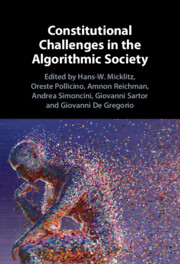Technologies have always challenged, if not disrupted, the social, economic legal, and to an extent, the ideological status quo. Such transformations impact constitutional law, as the State formulates its legal response to the new technologies being developed and applied by the market, and as it considers its own use of the technologies. The development of data collection, mining, and algorithmic analysis, resulting in predictive profiling – with or without the subsequent potential manipulation of attitudes and behaviors of users – presents unique challenges to constitutional law at the doctrinal as well as theoretical levels.
Historically, liberal constitutionalism has been built on a vertical dimension where the power to limit liberty is only the public one, only in given jurisdictional territory, and therefore should be constrained by the national constitution. Moreover, as of the rise of the bureaucratic state, the technologies for infringing liberty or equality were thought to be containable by the exercise of concrete judicial review (either constitutional or administrative), abstract judicial review, or a combination of the above. In recent years, however, the rise of the algorithmic society has led to a paradigmatic change where the public power is no longer the only source of concern for the respect of fundamental rights and the protection of democracy, where jurisdictional boundaries are in flux, and where doctrines and procedures developed in the pre-cybernetic age do not necessarily capture rights violations in a relevant time frame. This requires either the redrawing of constitutional boundaries so as to subject digital platforms to constitutional law or a revisiting of the relationship between constitutional law and private law, including the duties of the state to regulate the cybernetic complex, within or outside the jurisdictional boundaries of the state.
Within this framework, this book is the result of the biannual work of the IACL Research Group “Algorithmic State, Market and Society” after an inaugural conference at the University of Florence and European University Institute in 2019. This Research Group promotes the debate in the field of law and technology, and primarily regarding the new constitutional challenges raised by the development of algorithmic technologies which assist (if not control) decision-making processes by state agencies or corporations (often large and multinational) that provide key services online. Based on this framework, this book tries to answer the following research questions: How has the relationship among powers changed in the algorithmic society? What are the new substantive and procedural rights protecting individuals and democratic values? How can we balance innovation (and the legal incentives for businesses to pursue innovation) with the need to ensure transparency and accountability? To what extent should new forms of public or private law tools be developed to address the challenges posed by the shift to the algorithmic society?
The answers to these questions have likely changed in the last years due to the evolving landscape of algorithmic technologies and policy. The increasing implementation of algorithmic technologies in the public and private sectors promotes an intertwined framework. The launch of the European proposal for the Artificial Intelligence Act is just an example of the need to provide a framework for mitigating risks while promoting innovation. This book does not aim just to address recent developments and provide answers to evolving dynamics. The goal is to provide a taxonomy of the constitutional challenges of the algorithmic society, with some focuses on specific challenges.
This goal is reflected in the book’s structure, which is articulated in three parts. The first part aims to underline the challenges for fundamental rights and democratic values in the algorithmic society. In particular, this part underlines how the fast-growing use of algorithms in various fields like justice, policing, and public welfare could end in biased and erroneous decisions, boosting inequality, discrimination, unfair consequences, and undermining constitutional rights, such as privacy, freedom of expression, and equality. The second part addresses the regulation and policy of the algorithmic society. There are multiple challenges here due to opacity and biases of algorithmic systems, as well as the actors involved in the regulation of these technologies. The third part examines the role and responsibilities of private actors, underlining various constitutional opportunities and threats. In this case, the book aims to underline how the private sector is a relevant player, pursuing functions that reflect public powers.



